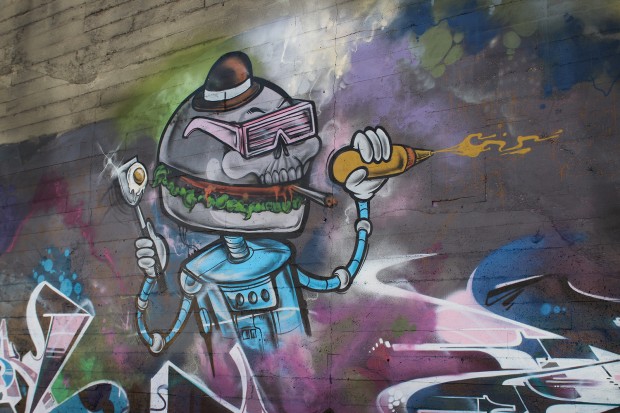
A mural on Willow Street in West Oakland
By Charles Berkowitz in Oakland North,
With several enlarged photographs of blighted Oakland property leaned up against the chamber windows, Oakland’s Public Works Committee convened Tuesday morning to consider a new graffiti ordinance that would bolster the city’s current vandalism laws. The ordinance, proposed by City Attorney Barbara Parker and District 3 Councilmember Nancy Nadel, would enhance penalties for violators, increase criminal charges from an infraction to a misdemeanor, and offer reimbursement to owners of repeatedly vandalized properties.
The committee, whose members include councilmembers Rebecca Kaplan, Larry Reid, Libby Schaaf, and Nadel, listened as the proposed “Graffiti Enforcement Program” drew criticism and praise from community members expressing their opinions about the new regulations. Supporters have praised the ordinance’s harsher penalties, believing it offers a strict antidote to Oakland’s excessive blight issues – even the trees in Oakland’s public parks aren’t immune from spray painted tags. But critics have raised concerns about the potential for heavy punishment for first time offenders, that the ordinance could disproportionately affect minors, and questioned how the city will differentiate between blight and street art.
District 2 Councilmember Pat Kernighan voiced her overall support for the ordinance, but cited the need to clarify abatement fines for local business owners whose property had been vandalized. Oakland’s Public Works department offers only one graffiti clean-up per private property; afterwards, the responsibility lies with the owner to abate the blight. Under current law, if private property isn’t fixed in ten business days, fines can start at $250 for the first offense, and increase to $1,000 per offense.
“They feel like they’re victimized twice,” Kernighan said of the property owners in her district. “I understand the city needs some mechanism to deal with people who ignore graffiti on their buildings, but this needs to be coupled with enforcement procedures.”
Paul Junge, who spoke of behalf of the Oakland Chamber of Commerce, echoed Kernighan’s sentiments, stating that a number of the chamber’s members have expressed concern that some of the penalties imposed on private business owners were “excessively punitive.”
“This is one of the few crimes where the crime victim can be seen as a criminal,” Junge said. “While the chamber understands the need for a comprehensive approach, [the committee] needs to address concerns of those who may feel victimized a second time.”
In his introductory remarks, Richard Illgen, Oakland’s Supervising Deputy City Attorney, said that because property owners can be cited for allowing graffiti to remain on their property, the ordinance aims to help those who are repeatedly targeted. It allows for civil actions to be brought by the city and affected property owners against violators. This includes recovery of damage costs and attorney fees.
The proposed ordinance will also be tougher on graffiti writers, allowing offenders to be charged with a misdemeanor instead of an infraction. Parents of minors could also be held liable for sustained damages. But, as an alternative to criminal charges, the proposed ordinance will offer offenders the option of participating in a restorative justice program, which allows the victim and offender to resolve the problem through community service or group conferencing. However, the ordinance is vague about which non-profit groups will actually handle these restorative justice cases.
Erin Yoshi, executive director for the Estria Foundation, a non-profit public arts organization, addressed the ordinance’s broad definition of graffiti, stating that “graffiti-styled” artwork could be considered vandalism under the new law. Mike “Bam,” a project manager for Estria who described himself as an “aerosol artist,” said he questioned whether Estria’s “graffiti” themed murals could be considered vandalism, and whether the new regulations would allow artists to repair defaced murals rather than have the city abate or “buff” them without the artist’s permission.
Yoshi went on to cite the city’s municipal code, which can penalize establishments for storage of permanent markers and pressurized paint cans. “We’re a non-profit and store many tools of graffiti,” she said. “The current law leaves us open for penalization.”
Nadel said that she proposed the ordinance in response to her business constituents along the San Pablo Avenue corridor, who regularly have to remove graffiti tags from their premises. She emphasized that the ordinance does not intend to discourage permitted art, and agreed that sections of the proposal need further consideration by the committee. “I want people to understand that the goal is not to limit art,” she said. “It is to get rid of unwanted, repeated blight on Oakland’s buildings. The issue is how we can control one aspect of graffiti and enhance the other.”
The Committee for Public Works will reconvene on December 11 for further discussion. A spokesperson for Nadel’s office said that a date has yet to be set for a final vote.
